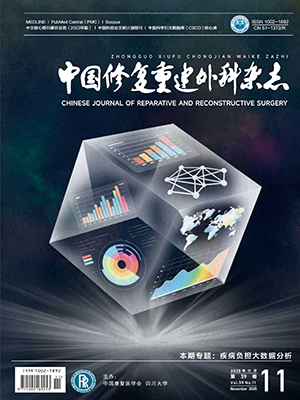| 1. |
Hu Y, Wu Y, Gou Z, et al. 3D-engineering of cellularized conduits for peripheral nerve regeneration. Sci Rep, 2016, 6: 32184.
|
| 2. |
Niu Y, Li L, Chen KC, et al. Scaffolds from alternating block polyurethanes of poly (ε-caprolactone) and poly(ethylene glycol) with stimulation and guidance of nerve growth and better nerve repair than autograft. J Biomed Mater Res A, 2015, 103(7): 2355-2364.
|
| 3. |
Prabhakaran MP, Ghasemi-Mobarakeh L, Jin G, et al. Electrospun conducting polymer nanofibers and electrical stimulation of nerve stem cells. J Biosci Bioeng, 2011, 112(5): 501-507.
|
| 4. |
Binan L, Tendey C, De Crescenzo G, et al. Differentiation of neuronal stem cells into motor neurons using electrospun poly-L-lactic acid/gelatin scaffold. Biomaterials, 2014, 35(2): 664-674.
|
| 5. |
Junka R, Valmikinathan CM, Kalyon DM, et al. Laminin functionalized biomimetic nanofibers for nerve tissue engineering. J Biomater Tissue Eng, 2013, 3(4): 494-502.
|
| 6. |
林强, 蔡杨庭, 李皓莘. 负载浓度梯度 NGF 的周围神经导管修复大鼠周围神经缺损的实验研究. 中国修复重建外科杂志, 2014, 28(2): 167-172.
|
| 7. |
Pereira T, Gärtner A, Amorim I, et al. Promoting nerve regeneration in a neurotmesis rat model using poly (DL-lactide-ε-caprolactone) membranes and mesenchymal stem cells from the Wharton’s jelly: in vitro and in vivo analysis. Biomed Res Int, 2014, 2014: 302659.
|
| 8. |
Saito K, Tamaki T, Hirata M, et al. Reconstruction of multiple facial nerve branches using skeletal muscle-derived multipotent stem cell sheet-pellet transplantation. PLoS One, 2015, 10(9): e0138371.
|
| 9. |
Li G, Xiao Q, Zhang L, et al. Nerve growth factor loaded heparin/chitosan scaffolds for accelerating peripheral nerve regeneration. Carbohydr Polym, 2017, 171: 39-49.
|
| 10. |
Cao J, Xiao Z, Jin W, et al. Induction of rat facial nerve regeneration by functional collagen scaffolds. Biomaterials, 2013, 34(4): 1302-1310.
|
| 11. |
Hu N, Wu H, Xue C, et al. Long-term outcome of the repair of 50 mm long median nerve defects in rhesus monkeys with marrow mesenchymal stem cells-containing, chitosan-based tissue engineered nerve grafts. Biomaterials, 2013, 34(1): 100-111.
|
| 12. |
Gu X, Ding F, Williams DF. Neural tissue engineering options for peripheral nerve regeneration. Biomaterials, 2014, 35(24): 6143-6156.
|
| 13. |
Yang XN, Jin YQ, Wei W, et al. Peripheral nerve repair with epimysium conduit. Biomaterials, 2013, 34(22): 5606-5616.
|
| 14. |
Iliakis G, Wang Y, Guan J, et al. DNA damage checkpoint control in cells exposed to ionizing radiation. Oncogene, 2003, 22(37): 5834-5847.
|
| 15. |
Rofstad EK, Mathiesen B, Galappathi K. Increased metastatic dissemination in human melanoma xenografts after subcurative radiation treatment: radiation-induced increase in fraction of hypoxic cells and hypoxia-induced up-regulation of urokinase-type plasminogen activator receptor. Cancer Res, 2004, 64(1): 13-18.
|
| 16. |
Nehls P, van Beuningen D, Karwowski M. After X-irradiation a transient arrest of L929 cells in G2-phase coincides with a rapid elevation of the level of O6-alkylguanine-DNA alkyltransferase. Radiat Environ Biophys, 1991, 30(1): 21-31.
|
| 17. |
Storme G, Mareel M, De Bruyne G. Influence of cells number on directional migration of MO4 cells in vitro. Arch Geschwulstforsch, 1981, 51(1): 45-50.
|
| 18. |
Weber B, Emmert MY, Schoenauer R, et al. Tissue engineering on matrix: future of autologous tissue replacement. Semin Immunopathol, 2011, 33(3): 307-315.
|
| 19. |
Piccoli M, Urbani L, Alvarez-Fallas ME, et al. Improvement of diaphragmatic performance through orthotopic application of decellularized extracellular matrix patch. Biomaterials, 2016, 74: 245-255.
|
| 20. |
Gilbert TW. Strategies for tissue and organ decellularization. J Cell Biochem, 2012, 113(7): 2217-2222.
|
| 21. |
Jessen KR, Mirsky R. The origin and development of glial cells in peripheral nerves. Nat Rev Neurosci, 2005, 6(9): 671-682.
|
| 22. |
Tamaki T, Okada Y, Uchiyama Y, et al. Clonal multipotency of skeletal muscle-derived stem cells between mesodermal and ectodermal lineage. Stem Cells, 2007, 25(9): 2283-2290.
|
| 23. |
Bollyky PL, Falk BA, Wu RP, et al. Intact extracellular matrix and the maintenance of immune tolerance: high molecular weight hyaluronan promotes persistence of induced CD4+CD25+ regulatory T cells. J Leukoc Biol, 2009, 86(3): 567-572.
|
| 24. |
Bollyky PL, Wu RP, Faik BA, et al. ECM components guide IL-10 producing regulatory T-cell (TR1) induction from effector memory T-cell precursors. Proc Natl Acad Sci U S A, 2011, 108(19): 7938-7943.
|
| 25. |
Morwood SR, Nicholson LB. Modulation of the immune response by extracellular matrix proteins. Arch Immunol Ther Exp (Warsz), 2006, 54(6): 367-374.
|
| 26. |
Brown BN, Valentin JE, Stewart-Akers AM, et al. Macrophage phenotype and remodeling outcomes in response to biologic scaffolds with and without a cellular component. Biomaterials, 2009, 30(8): 1482-1491.
|
| 27. |
Beattie AJ, Gilbert TW, Guyot JP, et al. Chemoattraction of progenitor cells by remodeling extracellular matrix scaffolds. Tissue Eng Part A, 2009, 15(5): 1119-1125.
|
| 28. |
Reing JE, Zhang L, Myers-Irvin J, et al. Degradation products of extracellular matrix affect cell migration and proliferation. Tissue Eng Part A, 2009, 15(3): 605-614.
|




